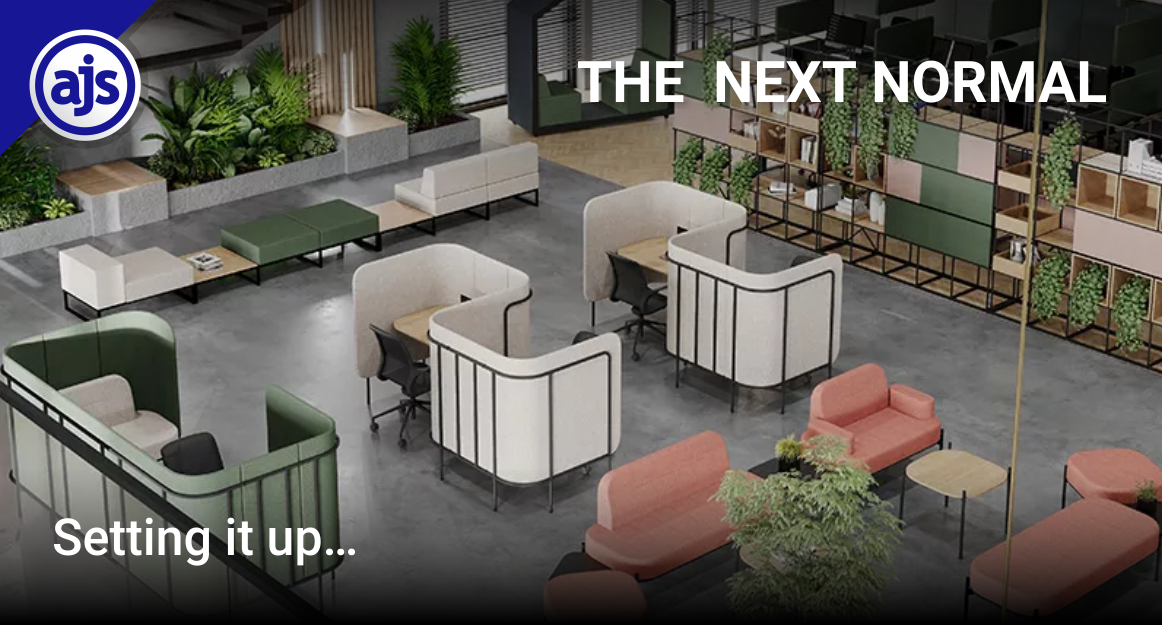
The Next Normal: Part IV
Setting it up…
We think it is safe to say that the “office” has changed. Substantially.
What was once rows and rows of desks and coffee machines, water dispensers and printers all in their little allocated spots, has turned into something different. Vastly different.
And most of us like it.
As we said in last week’s article – The Next Normal Part III: What does it look like – the office environment is now hybrid, it’s flexible, adaptable, agile and decentralised.
The focus is on bringing the workspace to employees, rather than the other way around. And that is a far cry from the commute employees would often have to do to get to the office every morning. There are differing feelings about the hybrid model but there is no denying that it cuts out on a long commute, naturally resulting in increased productivity.
Bringing the office to employees has also involved opening a string of smaller offices in readily accessible areas ensuring that employees can work from anywhere, on any device and still be able to dial into a meeting remotely while completing their tasks without a hitch.
It is a true balancing act between the physical office and the metaphorical one. Often needing a holistic blending of the two.
Naturally, the focus has moved away from assigned desks and canteens, to a space that has a renewed purpose. The office now serves as a place to spur innovation, connection amongst colleagues, team leaders as well as clients whilst also developing a kind of “team spirit” (according to hrfuture).
Seemingly, the purpose of an office has done a complete 360 (yes, that is intentional). A place where employees will want to go, instead of ”have to” go.
And that is what the Next Normal is all about.
Serving the needs of the employees, whilst ensuring that work is done optimally and efficiently. A win-win situation for the employer and employee. Mutually beneficial, mutually encouraging and mutually valuable. Enjoyable even.
“Who would’ve thunk it?”
There is also no denying that technology has a SIGNIFICANT role to play in how companies successfully pull off a hybrid working model. The value of tech – simply put – cannot be over-emphasised. Tech will be the brains whilst the new office will be the beating heart of all companies going forward.
The beating heart
An office has historically been seen as the centre of working life. A place where we had to go to sit at a desk and work our 8 hours. We would take an occasional coffee break and lunch timeout at the allotted hours. It kind of felt a little like herding cattle. At least it did if you were a mere cog in the machine.
But now the concept of what an office is or what it should be, hasbeen turned on its head.
Hybrid, flexible office environments have necessitated a transformation of the physical office space so that it accommodates the needs of all employees. Ensuring all employees are happy, motivated, and enthused with morale at an all-time high (because everyone could use that right about now).
It’s about ensuring that we all have an office that speaks to this new culture we are now a part of. We are not talking about bean bags versus sofas in the chill out rooms (although it could) nor are we insisting that a “half-pipe” be installed in the office common area (Did someone say Google? Yes, Google’s head office installed an indoor skateboard ramp in 2009. This year, an outdoor 4-foot-high half-pipe ramp was completed outdoors).
What we are saying is that some different practical considerations need to be considered. That does include downsizing into smaller workspaces to accommodate a hybrid work contingent, often in areas closer to where their employees are located. But it also includes considerations surrounding (according to Oktra) sustainable offices and offices that cater for neurodivergent employees and most importantly, technology, data and connectivity.
Sustainable offices
A sustainable office is not just about how many recycling bins there are. Rather it focuses on the entire aesthetic. Think instead of using “LED lighting, taking advantage of natural light and passive ventilation, sticking to low-emission materials and re-using or re-purposing furniture”.
In other words, businesses need to focus on lessening their environmental impact.
Smart offices
Smart offices are set up to collect and share data, informing businesses on when and how different spaces are being used. They can also monitor and respond to levels of occupancy, air quality and natural light levels. Employees will also be able to book their desks ensuring a smooth flow of staff. The result? A harmonious work environment where people can socially distance (if they choose to).
In addition, a smart office fully specked out with the latest technology can ensure a healthier workspace for employees (limiting transmission of whatever virus is going around) with thermal imaging systems, touchless doors, and further touchless sensor technologies.
Spaces for neurodivergent employees
As Oktra sets out –
“As companies shift towards more inclusive workplaces, there are several considerations that are being introduced into offices with greater intent. Neurodiversity is not a new concept in the workplace, and it has not always had the backing of employers, but the tide is changing.
Neurodiversity refers to the differences in our brain functions and our different approaches when interpreting information. ADHD, Autism, Dyspraxia and Dyslexia are all examples of neurodiverse conditions.
Considering our environments either enable or inhibit our ability to work, office design is a critical facilitator in ensuring your people play to their strengths. Designing spaces that offer support for different working needs is making offices more inclusive for workers on the spectrum. This includes quiet working zones, areas with sound and light control, a considered use of colours or fabrics to help create calming spaces. These design details help to make offices more inclusive and help support talent attraction and retention.”
Technology, data, and connectivity
As we set out in our previous article on what The Next Normal Looks Like the office in the Next Normal will incorporate “private booths with power and data integration, flexible and permanent desk space, breakout and touchdown zones and a range of AV meeting and training rooms to support several types of virtual collaboration, enabling staff to stay connected regardless of location”.
Providing quality work does not require a close physical proximity to a physical office. And that is an important consideration for a diverse and global work force.
The brains behind your operation
When lockdown set in, IT departments across the globe took emergency action to equip all employees with the right technology, which in some instances included new laptops and collaboration tools like Microsoft Teams and Zoom (which some employees needed training on) in order for employees to stay connected and operational during lockdown.
Now in a world that is (kind of) post pandemic, businesses need to embrace a smarter way of incorporating technology into their day-to-day work. Something ZDnet described as a “smart mode”. The need to reorganise a business to ensure greater flexibility with a maintained increased productivity has become the next urgent step.
And this all starts with the incorporation of the right technology into each practice. Perhaps the adoption of a kind of road map of what technology to deploy into each business (based on their own individual requirements) is just “what the doctor ordered”.
A roadmap that AJS can provide each and every law firm that needs it.
How AJS can help you
With a legal and accounting package to suit every law firm, no matter their size or requirements, AJS has a solution to suit everyone – just get in touch with us and we can tell you exactly how.
For example –
1. AJS Express – a web-based, flexible, full featured system that allows for document management, time recording, contracts management, FICA management and an asset register, to name but a few things;
2. AJS Pro – a web-based, flexible full-featured accounting and practice management system geared towards mid-size firms, that also includes an impressive integrated process automation, user task and notification tool;
3. AJS Enterprise – a comprehensive legal and professional accounting software package serving mid-size, large and major international firms with an impressive integrated process automation, user task and notification tool;
4. AJS FLOW – a powerful workflow automation tool that makes it easier to automate repetitive processes and increase output by improving control and ensuring that nothing slips through the cracks. Perfect for any process that has a defined set of steps or stages, thereby eliminating “busy” work and allowing lawyers to focus on the work that they choose to provide, and
5. XpressDox – is a powerful document assembly system managing your document automation needs with ease. You can create and run templates and you can save assembled Word/PDF documents to your local disk, a network drive, or the Cloud. It can be used as a stand-alone product, on a network, via the web (own-hosted or XpressDox-hosted), or even from within your own application or website.
Again, we reiterate that this is just the beginning of something truly “era-defining”. We need to take the correct steps now to ensure that not only future generations, but those of us within the workforce right now, are able to live more enriched (and less stressed) lives.
To embrace The Next Normal get in touch with AJS to find out how we can support you and assist you with incorporating legal technology into your practice.
Taking you into The Great Beyond. And beyond that too.
– Written by Alicia Koch on behalf of AJS





Leave a Reply